Menara Gardens Marrakech | Tour, History, Pavilion
… The Menara Gardens Marrakech is a huge and vast garden of 100 hectares. Dating back to the Almohad dynasty, it is located a short distance from the Wall of Marrakech. It is registered UNESCO World Heritage Site since 1985.
Being one of the oldest gardens in the West Muslim, what is its history ? What are its many legends ? Also What exactly does this fabulous site consist of ? And What are its purpose today ? How to get to one of the most emblematic gardens of Marrakech ?
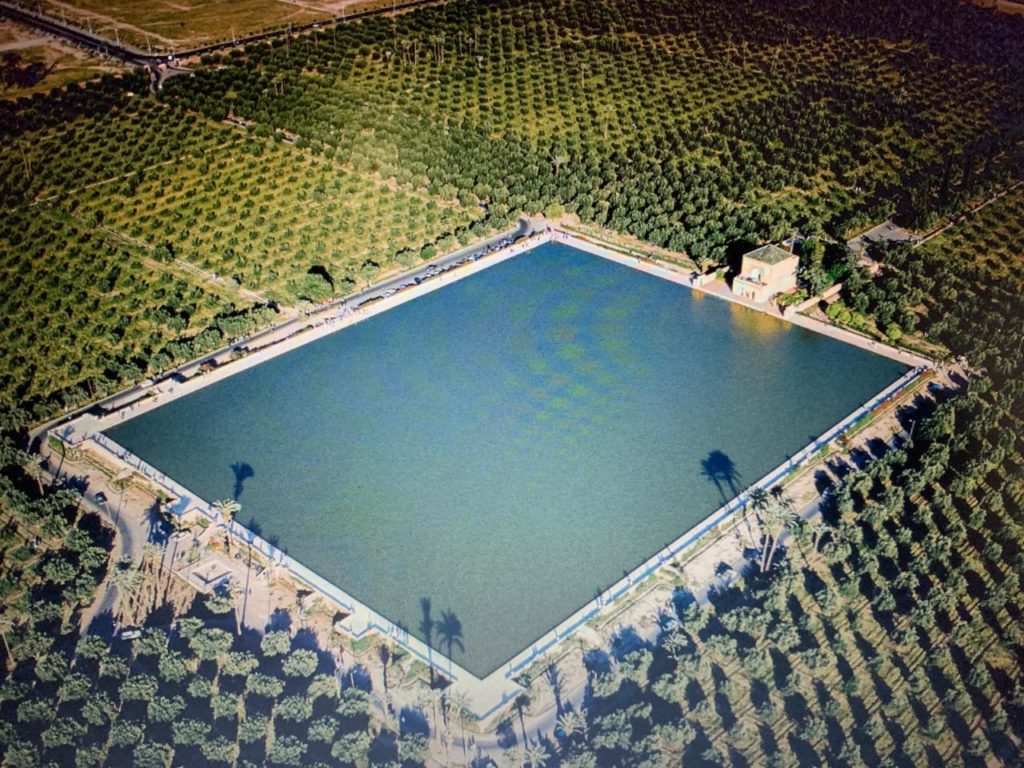
Discover the Article Madrassa Ben Youssef Marrakech | Magnificient Heritage of Islamic Art
1/ History of the Menara Gardens : from the Almohad origins to its legends
a- During the Almohad dynasty: creation of the Garden in the 12th century.
According to several literary sources, the origins of the Garden date back to the 11th century. That is to say at the time of the founder of the Almohad dynasty: Abd al-Mu’min (1094 /1106 -1163). In 1157, the latter ordered the work to be carried out on one of his returns from the coastal town of Salé. This was at the same time as the creation of the Garden of the Agdal.
Since March 23rd, 1147, Marrakech became the capital of the Empire of the Almohads. They ruled a vast territory encompassing the entire Maghreb and Al Andalus. The Almohads built many palaces and religious buildings throughout their empire. Among them are the Koutoubia Mosque, the Bab Agnaou Gate, etc. in Marrakech.
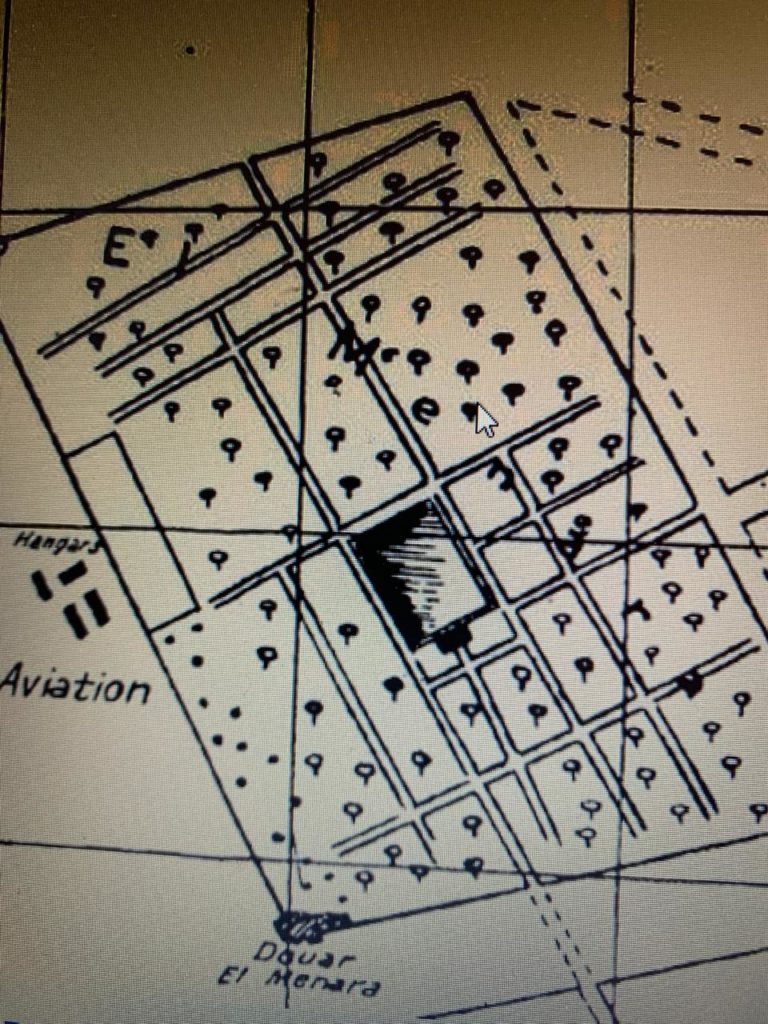
In 1157, Abd al-Mu’min decided to create the Gardens “to the west of his palace towards the Neffis”. He gave the execution to Haji Ibn Yaish, a scientist and legislator of the empire. The Garden was therefore to have a military and utilitarian function in addition to its function as a place of pleasure and ornament for the residents:
- To serve as a huge fruit and vegetable orchard irrigated by a large storage basin, by underground drains “khettarras” used since the ancient Almoravid dynasty.
- Serve as a swimming pool and resting place for Almohad troops returning from military service.
Located 2.5 km from the Wall surrounding Marrakech, the Garden was connected to the city by a road built at the same time. From the Royal Palace, a gate known as “Bab El Mahzan” was used. Palace, gate and road were destroyed during the XIIIth century – only the Garden, by religious belief, survived the destruction.
Discover the Article Koutoubia Mosque Marrakech Morocco| History & Architecture
b- From the Saadians to the Alaouites : the embellishment and construction of the Pavilion
During the Sadian dynasty and until the advent of the Alawite dynasty – although there are few sources concerning this period – only small repairs were made to the garden, allowing the sultans and other caliphs to rest there.
Sources speak of a building serving as a resting place for sultans and caliphs, and for troops of soldiers at the present location of the pavilion.
It is rather under the Alaouite era that the sources inform us about the embellishment of the garden with :
- Creation of an adobe wall all around the garden
- Creation of the Pavilion in 1866 and its surrounding wall by order of Sultan Sidi Mohammed in order to establish his summer palace.
At the end of the 19th century, a new adobe wall was built to encircle the olive grove and slightly enlarge the garden, the perimeters were also renovated in adobe.
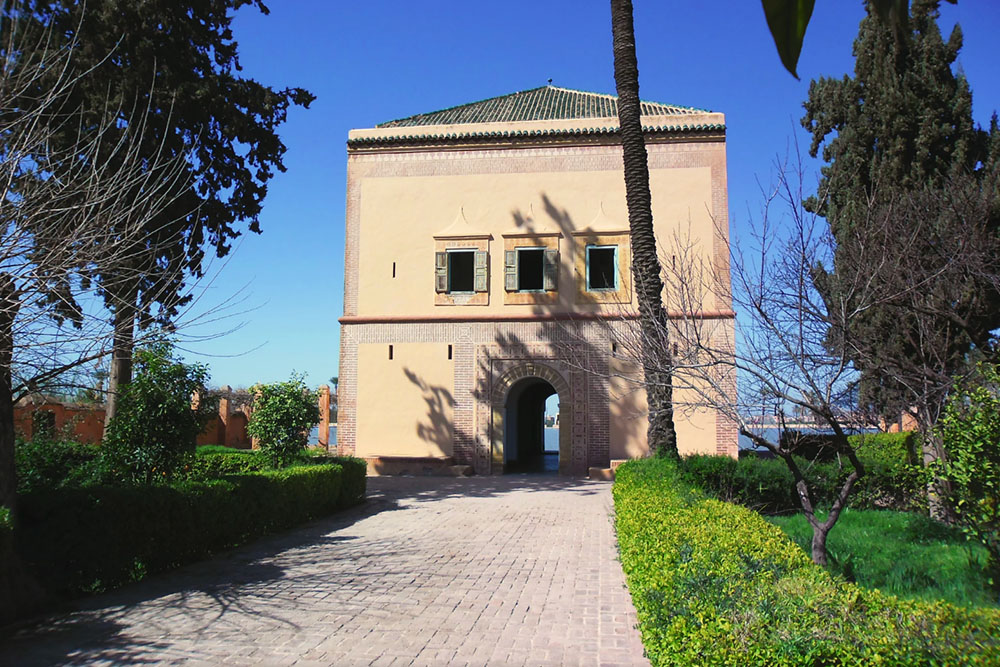
Discover the Article The Gardens of Marrakech | Exoticism and Poetry
c- Myths and Legends of the Menara Gardens Marrakech
Several legends have been passed down through the centuries concerning the basin of the Garden of the Menara – in chronological order :
- The very founder of the city of Marrakesh, Abu Bakr ben Omar, is said to have buried there, under the present basin, all the booty he collected during his Islamic conquests and his numerous lootings.
- In the 12th century, under the Almohad dynasty, the basin would have been used as a swimming pool so that the soldiers could train there. The aim was to swim across the Mediterranean to reach the desired Al Andalus.
- The Lake of the Garden was considered to be a real cemetery. In the 17th century, Sultan Moulay Ismail, who was known as the “executioner of hearts”, is said to have drowned many of his conquests there after having thrown them from the balcony of the Pavilion.
Discover the Article History of Marrakech | The Great Era of the Buiding Sultans
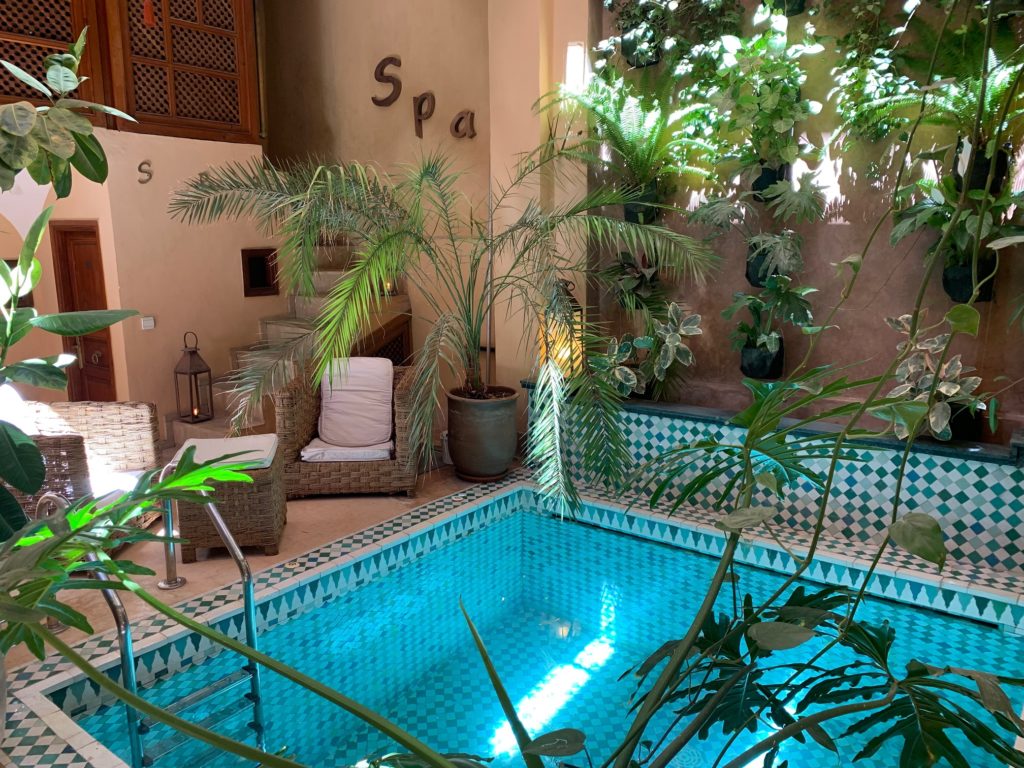
Visit the Spa of Riad Al Ksar : Hammam & Massages Duo
2/ Tour and Description : a fabulous garden in Marrakech
Classified as an UNESCO World Heritage Site since 1985, the Menara Garden consists of a large pool and a pavilion outside the Olive Garden.
a- The basin of the Menara Gardens Marrakech
Located in the middle of the garden, the pond or reservoir is a huge area of water with a surface area of 195 by 160 metres. Built above ground level to irrigate the surrounding gardens by gravity, it is shallow however. It is supplied with water by a hydraulic system more than 700 years old. These are the famous “khetarras” or underground drains – which carry water from the Atlas Mountains, located 50 km from Marrakech.
This basin makes it possible to supply water to the immense olive grove and the whole garden in a mechanical way. Indeed, it is manually that the Gates are opened at staggered times in order to optimise watering according to the dry or rainy seasons, and according to very precise trajectories.
For anecdotes, the pond is full of fish, and carp in particular, which can be fed. It is possible to cross the pond at the water’s edge on slightly submerged plots as “Moses crossing the water” effect.
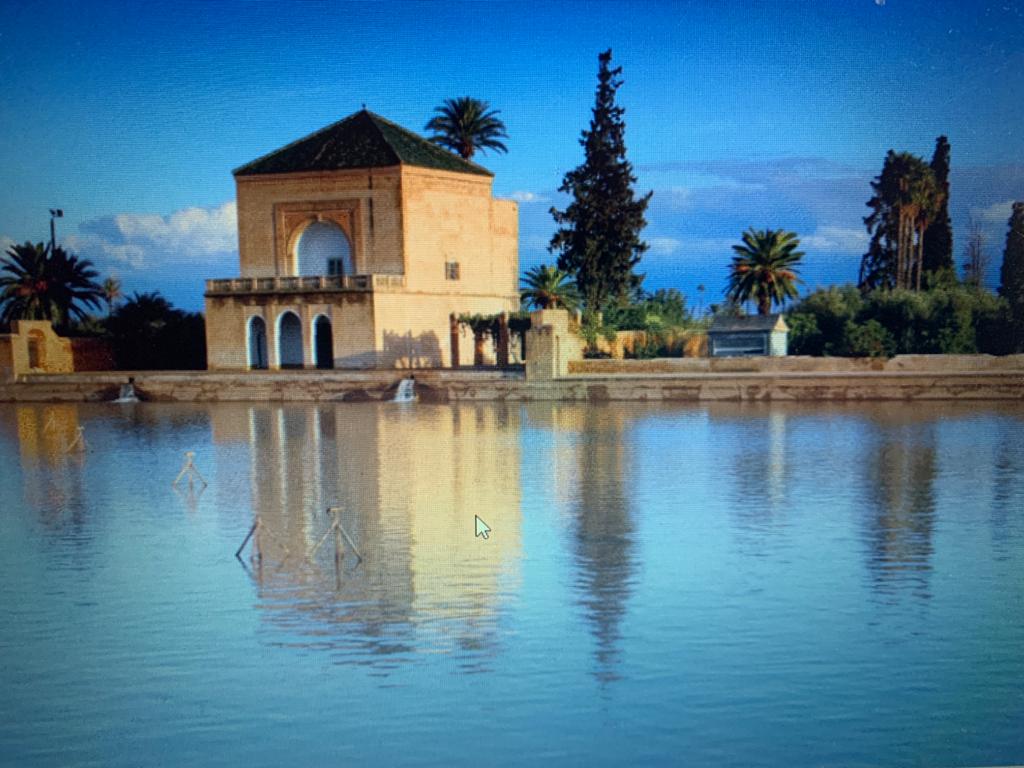
Discover the Article Maps of Marrakech | To print & Download
b- The Garden Pavilion
At the southern end of the basin, a pretty pavilion is set up. Built in 1866 by the Sultan Sidi Mohammed, probably replacing an older site, it is surrounded by its own enclosed garden.
With a surface area of 12mx12m, it was used by the sultans and other courtiers. It consists of several rooms, loggias and a large terrace, from which the entire architectural plan of the garden has been revealed. The pyramid-shaped green tile roof gives it its charm.
Note that from the terrace, looking towards the city (to the right) and aiming at the Koutoubia Mosque – a pretty axis appears.
It is thought that the origin of the name Menara would come more or less from this axis, as the Arabic meaning of Menara would be the lighthouse, or the minaret. Moreover, this pavilion is often nicknamed the “Menzeh“, which is the equivalent of the lighthouse.
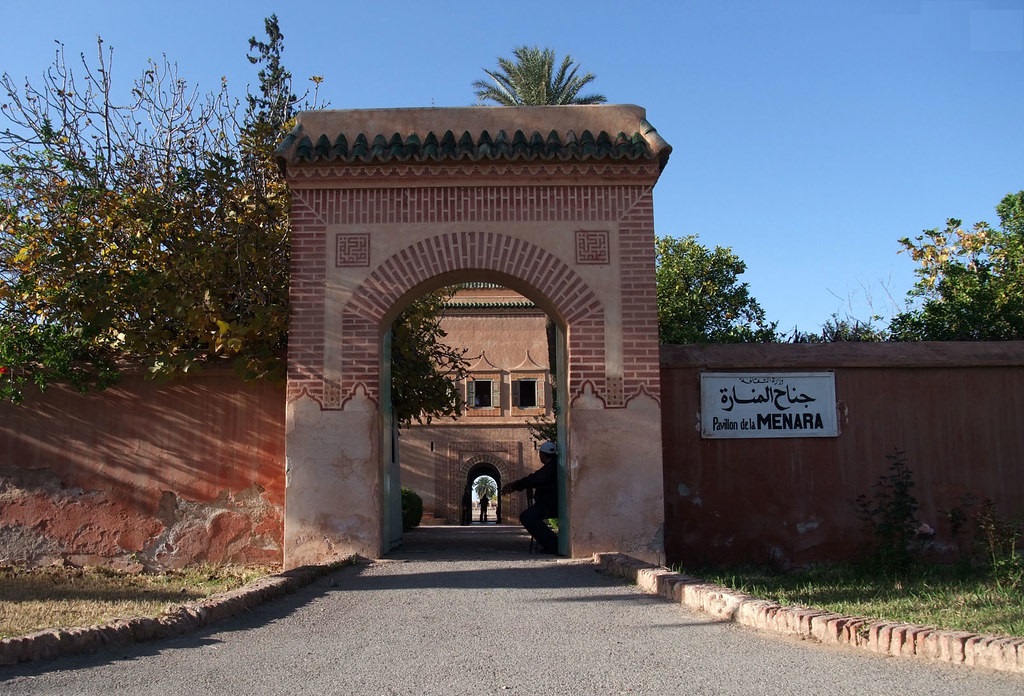
Discover the Article What to see in Marrakech ? During a 3 Days / Nights break & more
c- The Menara Gardens
The Menara gardens Marrakech represent a significant part of the total area of the site, which is almost 100 hectares. Olive trees are in the majority, with about forty different species. But date palms and fruit trees coexist here, making this orchard one of the largest gardens in Marrakech. At the end of October, when the olive are harvested, many workers are present with their ladders and their baskets in doum (palm fibre).
3/ How to get to the Menara Gardens Marrakech and What to do ?
a- How to get there?
There are several ways to get to the Menara Gardens Marrakech, depending on your physical abilities and your price negotiation skills:
– On foot in 30 minutes from the Jemaa El fnaa Square – via the Menara Avenue – depending on your physical capacity (about 3km). There is very little shade on this avenue despite the planting of several pretty little gardens, so you should avoid the hours of high heat.
– By bus via the L11 which passes by the Koutoubia Mosque and stops in front of the Garden gates, it will cost you between 2 and 4 dhs maximum. Ask the driver to show you the stop for the Garden.
– By taxi, count 20dhs from Jemaa El fnaa Square. Be sure to ask the driver to put the meter on in order to pay the real price – otherwise by negotiation never exceed 50 dhs for this trip for up to 3 people.
– By horse-drawn carriage, from the Jemaa El fnaa Square – from 4 to 6 people, pay approximately 70 dhs maximum the journey.
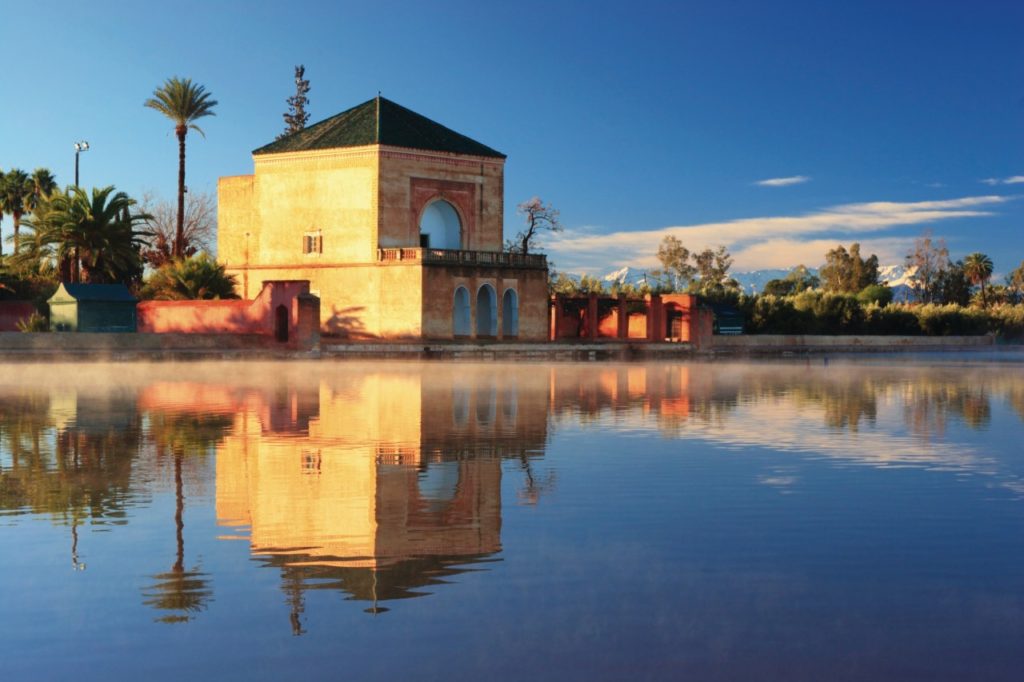
Discover the Article Jemaa El Fnaa Square Marrakech | History & Culture
b- What to do in the Menara Gardens ?
Many times several populations cross in the streets and paths of the garden:
– Tourists to visit the second largest garden in Marrakech, after the Agdal. They take pretty pictures there from the end of the basin in front of the Pavilion. Ideal in good weather and if luckily there is still snow on the Atlas peaks. From this point of view, you can see the reflection of the snowy peaks of the Atlas Mountains in the water of the Basin. Guaranteed ecstasy. Also, from the balcony terrace of the Pavilion, an extraordinary view is offered to you on the whole of the Garden and part of the city of Marrakech.
– Marrakchis love to stroll there as lovers, with family or friends. Indeed the garden is a refreshing setting and an island of greenery and shade during the hottest periods. Many locals picnic in the shade of the olive trees.
– Sportsmen love to run there. The menara garden is indeed a less polluted green area compared to sports activities along the polluted main boulevards.
High tourist place of Marrakech not to be missed, the Menara Gardens Marrakech is grandiose. It is the example of a typical Muslim Western garden that has been preserved for centuries.
After discovering the Garden of the Agdal, the new Garden of Arts or the Jnane El Harti, discover the Menara gardens for a walk or a photo shooting with the snowy summits (from November to April) of the Atlas Mountains in the background.
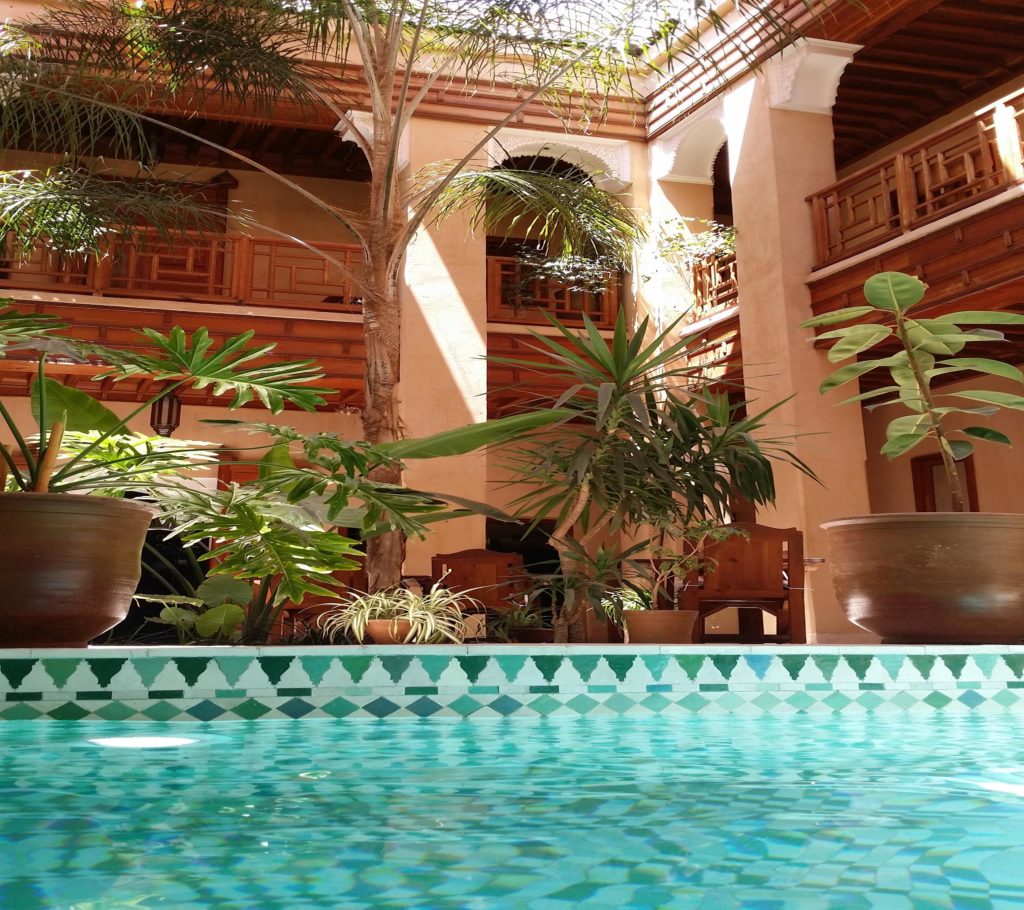
Visit Riad Al Ksar & Spa, in the Médina near Jemaa El Fnaa square
Practical Information Menara Gardens Marrakech
Open Monday to Sunday from 9am to 5pm.
Free entrance to the Garden, Visit of the Pavilion 20 dirhams
Possibility of camel rides in front of the Garden entrance.
The following Articles may interest you :
How to Get Around Marrakech Bus Taxi Aiport Transfer Train Station
El Badi Palace Marrakech | Glory of the Saadian Dynasty
Bahia Palace Marrakech | 19th Century Masterpiece
oli ©alksar 2020 – https://www.alksar.com
Copyright Disclaimer: USE NOTICE : This site contains copyrighted graphic material the use of which has not always been specifically authorized by the copyright owner. We are making such material (images) available in an effort to advance understanding of cultural and social subjects, etc. We believe this constitutes a ‘fair use’ of any such copyrighted graphic material.

